In today’s digital landscape, local businesses are increasingly relying on social media to reach their audience. However, social media marketing alone may not be sufficient to drive business growth.

A comprehensive online marketing strategy is crucial for local business marketing success. This includes a combination of social media, search engine optimization (SEO), and other digital marketing tactics to increase online visibility and attract more customers.
Table of Contents
Is social media alone enough for visibility?
No, social media alone is not enough for visibility. While it’s a powerful tool to reach and engage audiences, relying solely on it limits your reach to platforms’ algorithms and user behavior. Combining social media with strategies like SEO, email marketing, content creation, and partnerships ensures broader visibility and long-term growth.
The landscape of social media marketing for local businesses is rapidly evolving, with new platforms and strategies emerging regularly. This shift is driven by the ever-changing algorithms and user behaviors on various social media platforms.
Why are reviews stronger than posts and likes?
Reviews are stronger than posts and likes because they provide detailed, personal experiences that build credibility and trust. Unlike a simple like or post, a review shows that someone took the time to engage deeply with a product or service, offering insights that influence others’ decisions. This makes reviews far more persuasive and valuable for shaping opinions and driving action.
Are you relying solely on social media to grow your local business?
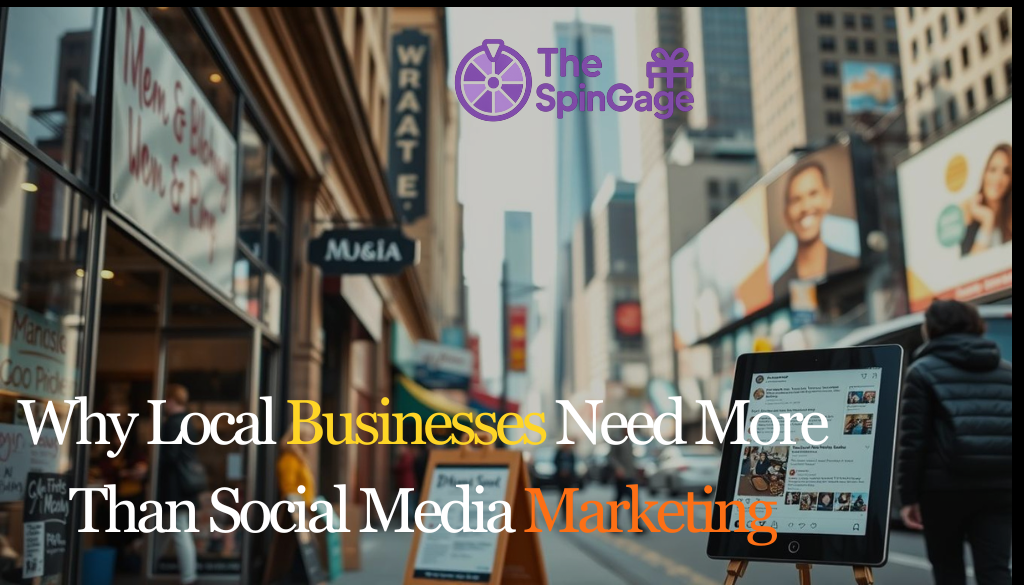
While platforms like Facebook, Instagram, TikTok, and YouTube offer incredible reach, the reality is that social media marketing alone is no longer enough to drive consistent growth. Algorithm changes, demographic limitations, and increasing competition mean that even businesses with large followings may struggle to reach their target audience effectively.
To truly thrive in today’s digital landscape, local businesses need a comprehensive online marketing strategy that goes beyond social media. By integrating local SEO, email marketing, content creation, and optimized website strategies, you can build a robust online presence that attracts high-intent customers, increases visibility, and strengthens your brand’s credibility. Diversifying your marketing approach not only safeguards your business against the unpredictability of social platforms but also ensures that every marketing dollar invested delivers measurable results.
How does SpinGage complement social media marketing?
SpinGage complements social media marketing by providing a comprehensive online marketing strategy that goes beyond just posts and ads. It helps local businesses attract more targeted traffic, engage customers effectively, and convert leads into sales, ensuring that social media efforts translate into real business growth.
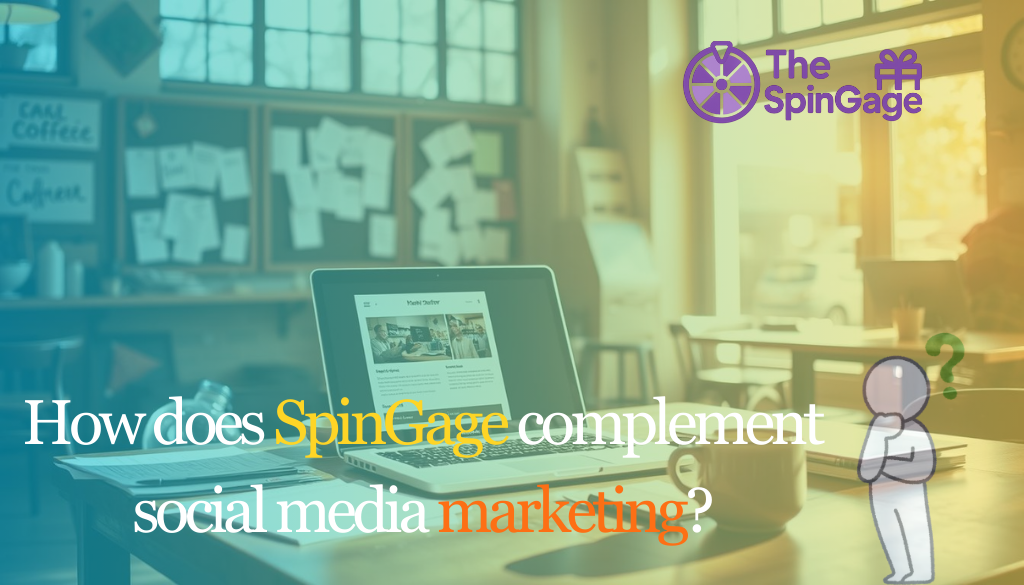
How does SpinGage automate review collection?
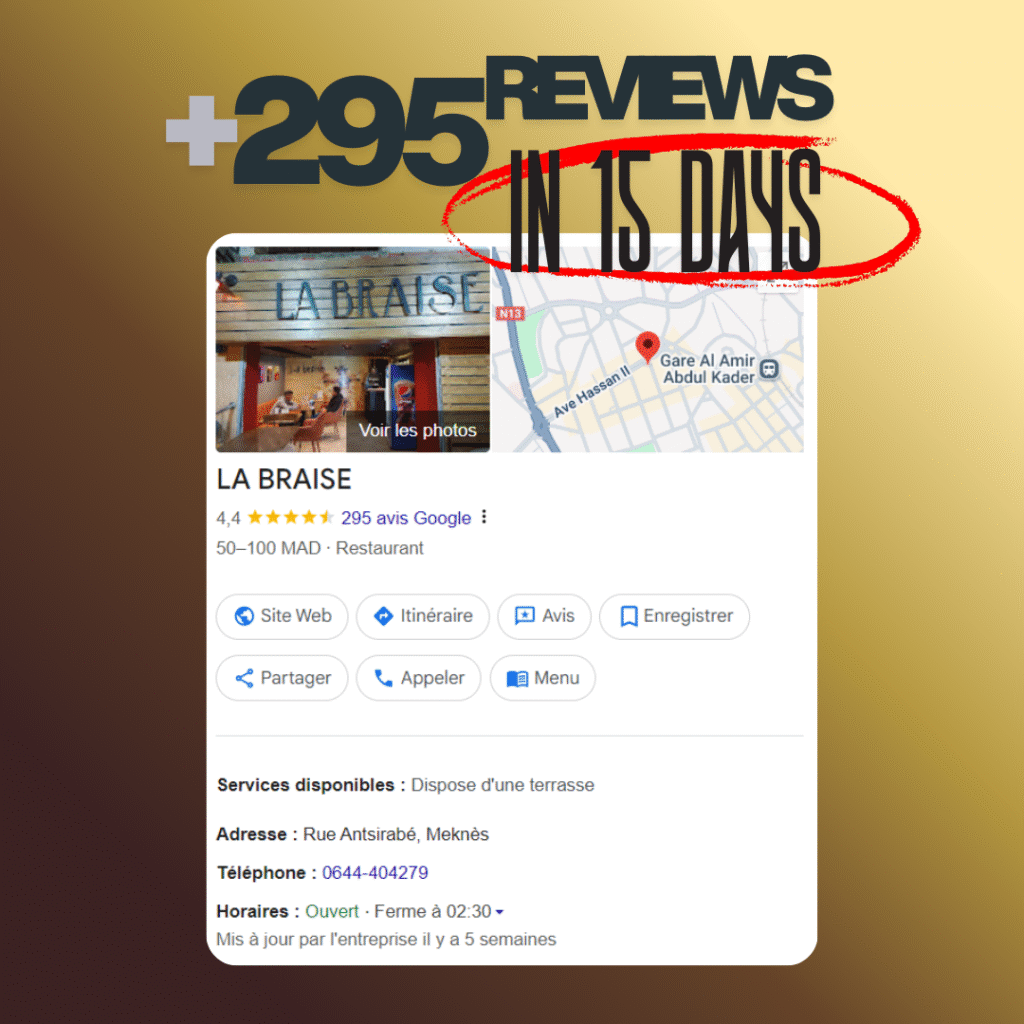
+295 REVIEWS IN JUST 15 DAYS :
Labraise is a restaurant that gained more than 295 new customer reviews and increased their income by using TheSpinGage solution.
They placed a flyer with a QR code on every table, allowing each diner to scan and spin the wheel. Labraise used a 100% winning ratio plan, where customers always won either 10% off their meal or a free soda.
This simple gamification encouraged guests to leave reviews, boosted loyalty, and kept customers coming back.

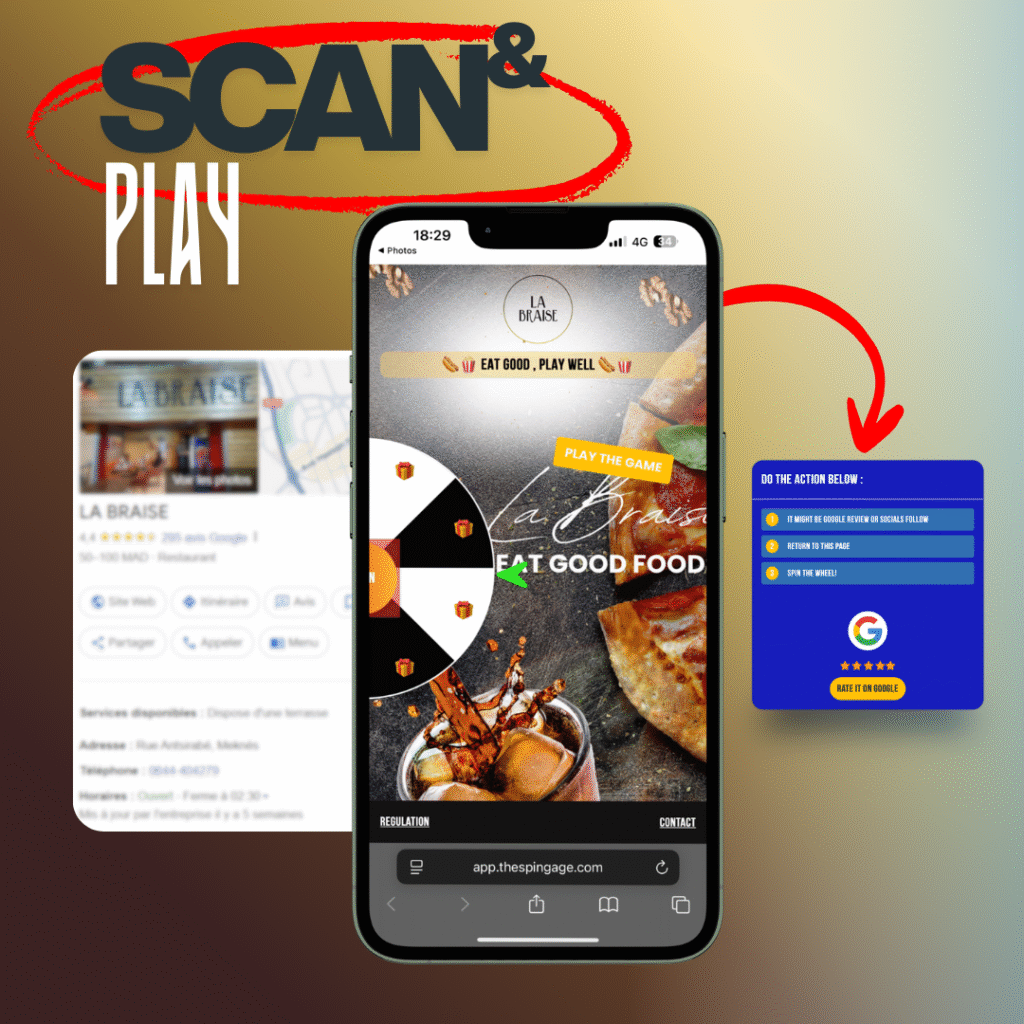
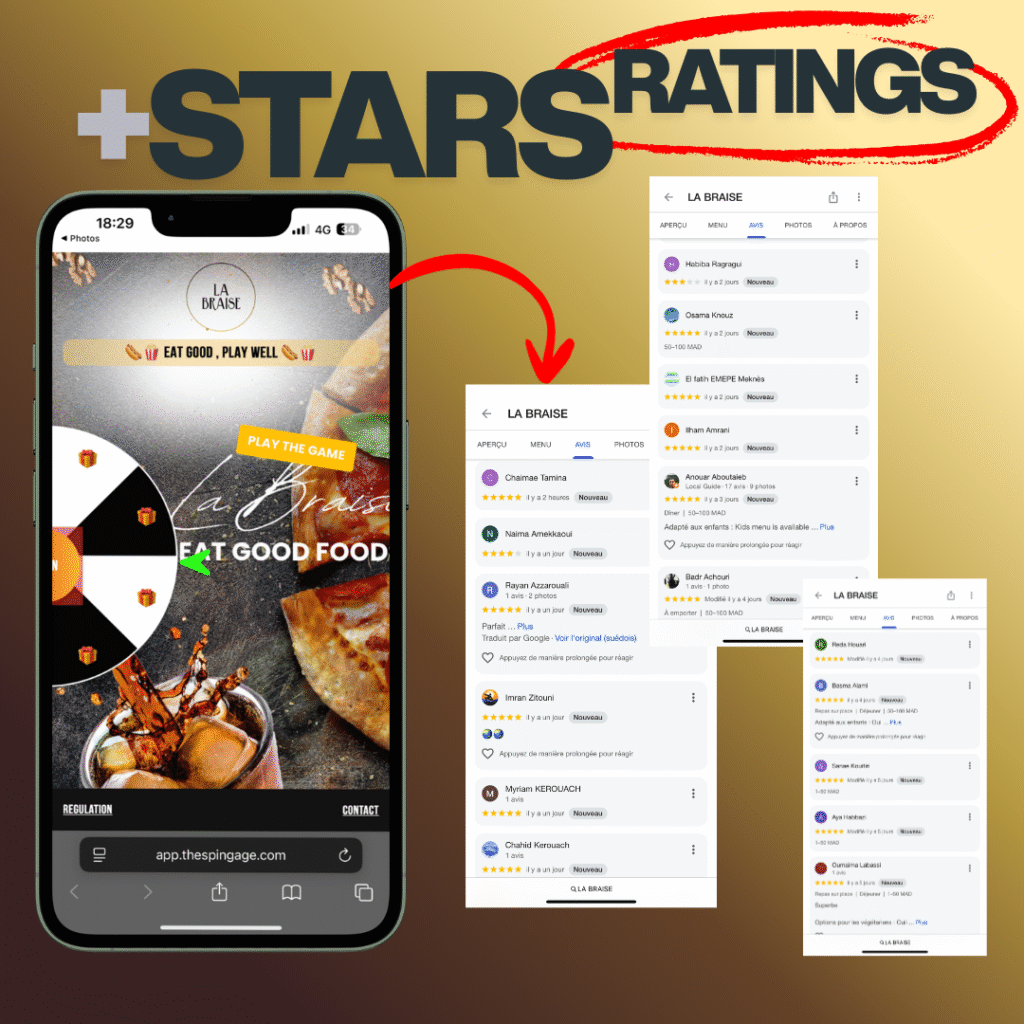
HOW IT WORKS IN 4 EASY STEPS ?
1 – Scan the QR Code
Clients simply scan the QR code placed on the table or provided directly by you.
2- Take Action First
To unlock the gameplay, they must complete the required action.
3- Spin the Wheel
Once unlocked, they spin the wheel to test their luck.
4- Win Rewards
If they win, a QR code is instantly sent to their email. If not, nothing happens. In both cases, the game is locked for 24 hours, ensuring fairness and excitement for the next try.
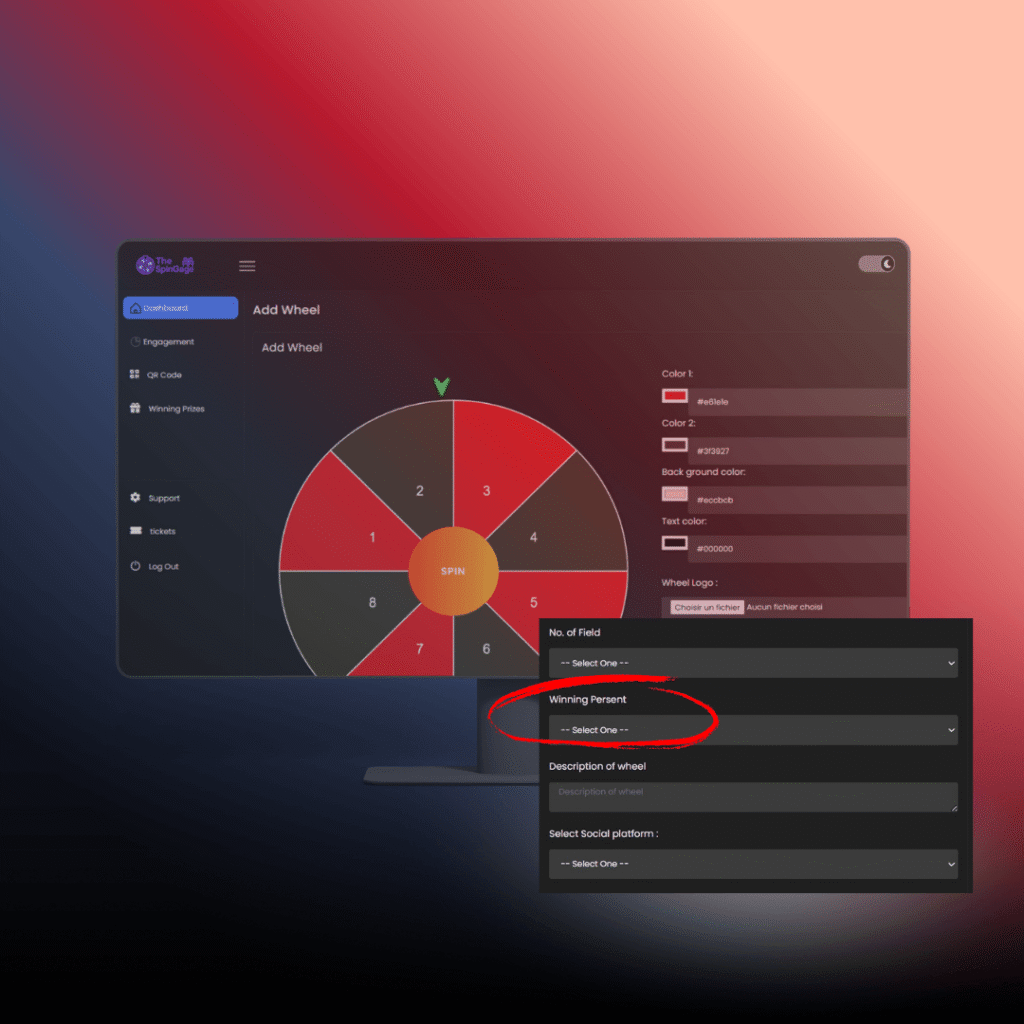
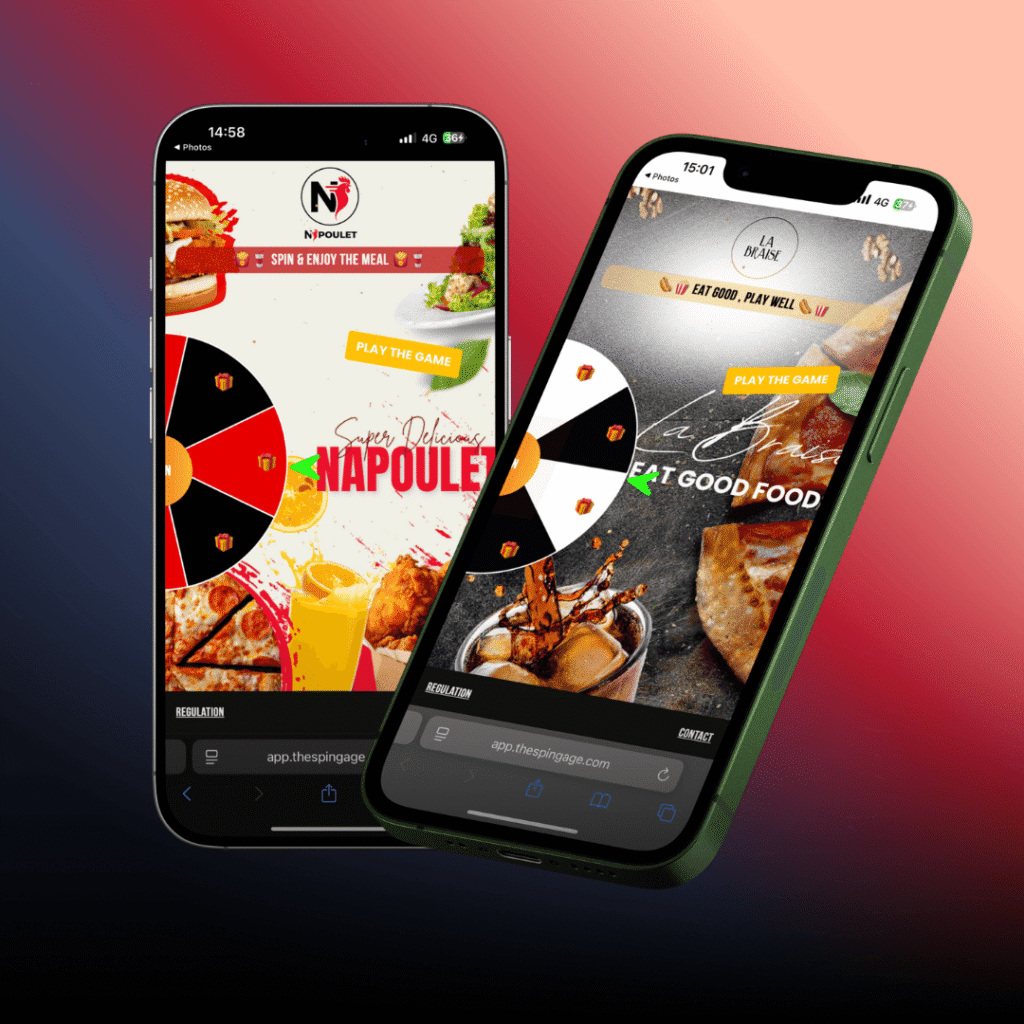
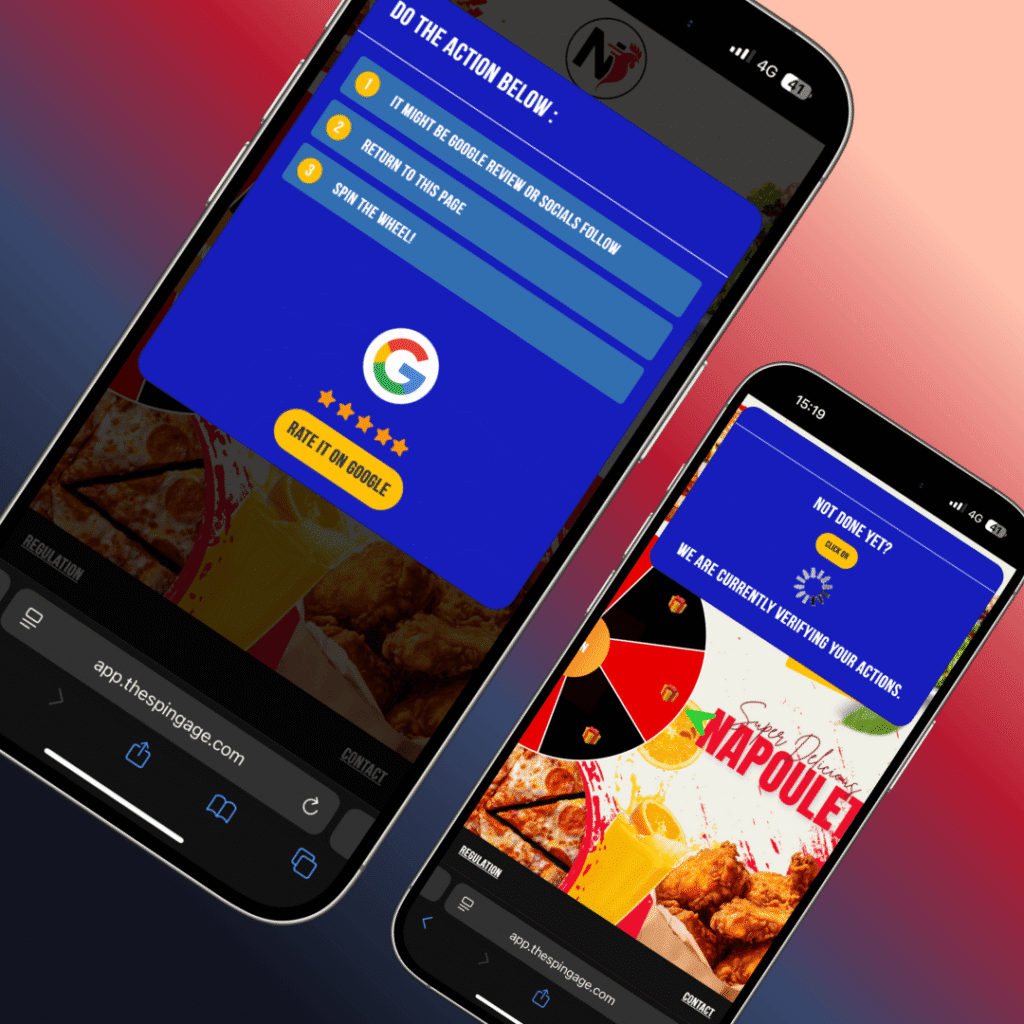
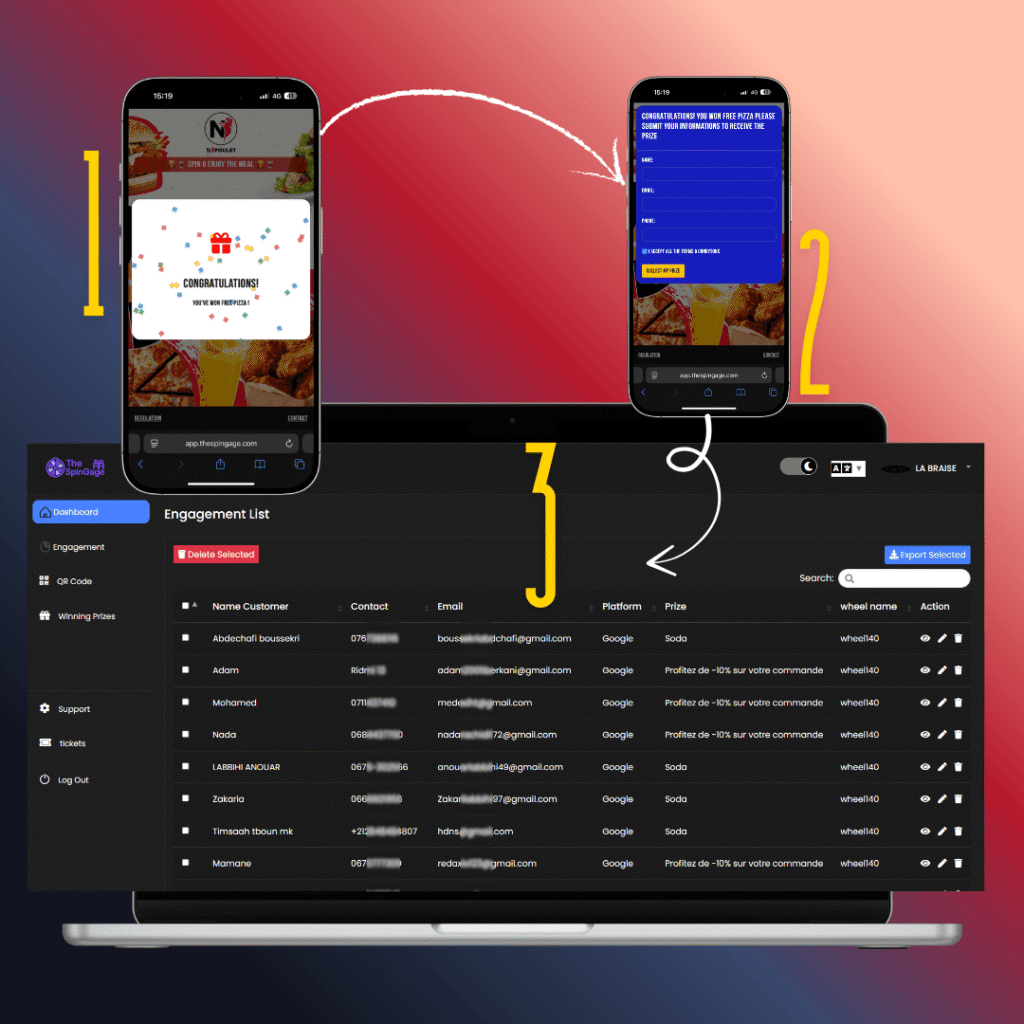
🛠️ Flexible Tracking Options
Track platform Top performing .
Track the wheel segments (number of prizes, Winner Gameplay).
Number of Plays , Track top performing wheel
Set up expiration dates for vouchers and offers.
Get Acces to LEADS , Extraxt & Modiify it .
Why You Should Opt for TheSpinGage Solution
Running a business today is not just about serving customers – it’s about creating memorable experiences that keep them coming back and spreading the word. That’s exactly what TheSpinGage delivers.
🎯 Stand Out from Your Competitors
Most restaurants, cafés, and shops rely only on discounts or word of mouth. With TheSpinGage, you turn every visit into a fun, interactive moment that clients remember and talk about.
⭐ Collect More Positive Reviews
Google reviews are the new “digital reputation.” Our system motivates clients to leave reviews in exchange for a chance to win rewards – giving you the social proof that attracts new clients effortlessly.
💌 Grow Your Customer Database
Every spin is an opportunity to collect emails and data, helping you stay connected with your clients through newsletters, promotions, and loyalty campaigns.
🔄 Boost Loyalty and Repeat Visits
Customers love rewards. By making every visit a chance to win, you encourage repeat visits, turning occasional clients into loyal fans of your business.
⚡ 100% Simple & Automated
No technical headaches. Once installed, TheSpinGage works automatically – whether through QR codes on tables, flyers, or digital screens. You just set the rules, and the system does the rest.
👉 TheSpinGage isn’t just a tool – it’s your new customer magnet.
Increase engagement, grow your reviews, and build a strong database without spending more on ads.
📲 Activate TheSpinGage today and turn visitors into loyal, returning customers!
START TODAY

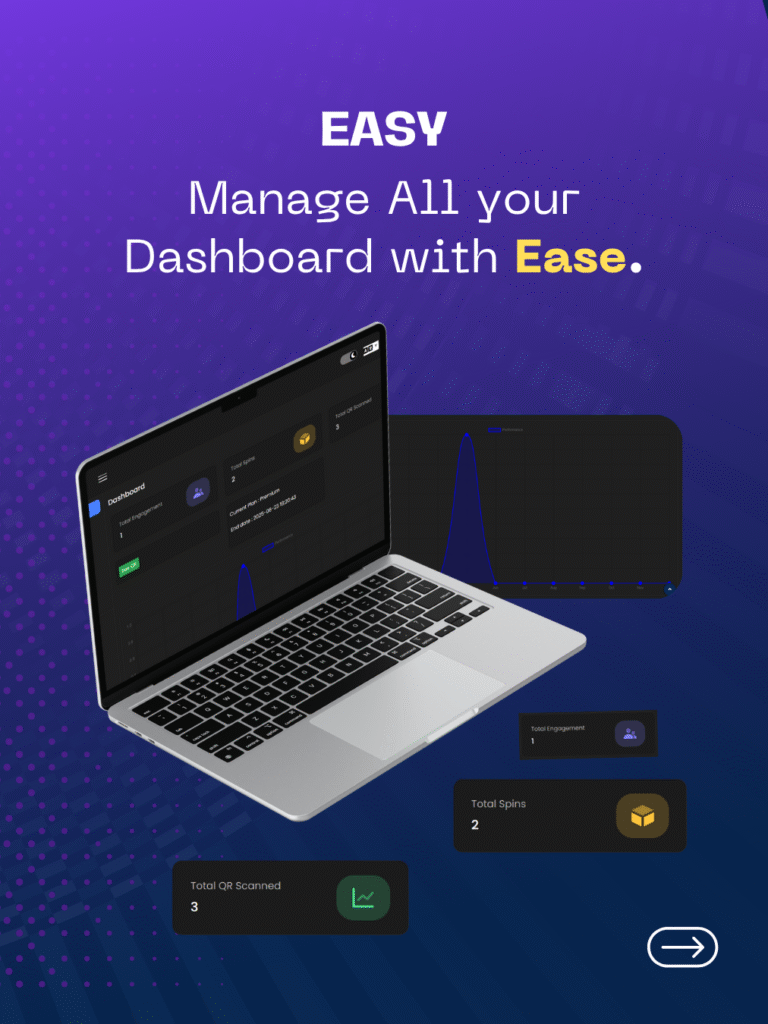
SpinGage automates review collection by seamlessly integrating with your business platforms to prompt customers for feedback at the right moment. It can automatically send personalized review requests via email or SMS after a purchase or service, making it easy for customers to share their experiences. This automation not only increases the volume of reviews but also ensures consistent and timely feedback, helping businesses maintain a strong online reputation without manual effort.
Combine this with strategic local SEO practices, including keyword research, category optimization, and building citations and backlinks, and you’re positioning your business to dominate local search results in 2025. Monitoring analytics and a
If you’re ready to stop leaving your business growth to chance and start implementing a marketing strategy designed for real-world results, it’s time to take action.
Boost Your Local Business Growth Now
Facebook and Instagram for Local Engagement
Facebook and Instagram remain top choices for local businesses due to their vast user bases and robust advertising capabilities. Facebook’s diverse user demographics and Instagram’s visual-centric platform make them ideal for different marketing strategies.
TikTok and YouTube for Visual Storytelling
TikTok and YouTube are gaining traction for their ability to facilitate engaging visual content. TikTok’s short-form videos and YouTube’s long-form content cater to different audience preferences, allowing businesses to diversify their content strategies.

How Local Businesses Typically Use Social Media
Local businesses use social media to connect with their audience, promote products, and build brand awareness. Their strategies often involve a mix of organic and paid content.
Common Posting Strategies
Common posting strategies include:
- Sharing updates about products or services
- Engaging with customers through comments and messages
- Posting promotional offers and events
Advertising Approaches
Advertising on social media allows local businesses to target specific demographics and increase their reach. Effective advertising approaches involve:
- Using targeted ads based on user data
- Creating compelling ad content that resonates with the target audience
- Monitoring and adjusting ad campaigns for optimal performance
Why Local Businesses Need More Than Social Media Marketing
In today’s digital age, local businesses need to diversify their marketing strategies beyond social media to reach their target audience effectively. While social media is a powerful tool, its limitations can hinder a business’s ability to connect with customers and grow their brand.
Algorithm Changes and Declining Organic Reach
One of the primary concerns for local businesses is the constant change in social media algorithms, which has led to a decline in organic reach. This means that even if a business has a large following, their posts may not be seen by as many people as they once were. As a result, businesses are finding it increasingly difficult to get their message across without paying for advertising.

Increasing Competition for Attention
The competition for attention on social media is fierce, with businesses competing against each other, as well as against content from friends, family, and even viral trends. This makes it challenging for local businesses to stand out and capture the attention of their target audience.
Demographic Limitations of Social Platforms
Social media platforms have demographic limitations that can affect a local business’s ability to reach their target audience. For instance, certain age groups may be more prevalent on specific platforms.
Age and Geographic Gaps
Some social media platforms may have a higher concentration of younger users, while others may have more older users. Additionally, geographic gaps can exist where certain regions or cities have a stronger presence on specific platforms. Local businesses need to be aware of these gaps to effectively target their audience.
Platform-Specific User Behaviors
Different social media platforms have unique user behaviors. For example, users on Instagram may be more visually driven, while users on Twitter may be more focused on real-time information. Understanding these behaviors is crucial for local businesses to tailor their content and marketing strategies effectively.
By recognizing the limitations of social media and incorporating other marketing strategies such as local SEO, email marketing, and content marketing, local businesses can create a more robust online presence and better connect with their target audience.
The Limitations of Social-Only Marketing Strategies
Social media marketing, while powerful, has its limitations when used as the sole marketing strategy for local businesses. As local businesses increasingly rely on social media, they face several challenges that can impact their overall marketing effectiveness.
Rented vs. Owned Marketing Channels
One of the primary limitations is the distinction between rented and owned marketing channels. Social media platforms are considered rented channels because businesses don’t own the space or the audience list. This means that changes in platform policies or algorithms can significantly affect their reach and engagement.
Dependency on Platform Policies
Local businesses are at the mercy of social media companies’ policies and changes. For instance, algorithm updates can reduce organic reach, forcing businesses to invest more in paid advertising. This dependency can be risky and costly.
Difficulty in Measuring True ROI
Measuring the return on investment (ROI) of social media marketing is challenging due to attribution and conversion tracking issues.
Attribution Challenges
Attribution challenges arise when trying to determine which marketing efforts are driving conversions. With multiple touchpoints involved in a customer’s journey, accurately attributing sales to specific social media campaigns can be complex.
Conversion Tracking Issues
Conversion tracking is also problematic due to the limitations in tracking user behavior across different platforms and devices. This makes it difficult to get a complete picture of how social media efforts are impacting overall sales.
| Marketing Channel | Ownership | Control Level |
|---|---|---|
| Social Media | Rented | Limited |
| Email List | Owned | High |
| Website | Owned | High |
In conclusion, while social media is a valuable tool for local businesses, relying solely on these platforms can limit their marketing potential. By understanding the limitations and diversifying their marketing strategies, local businesses can build a more robust online presence.
Building a Strong Online Foundation Beyond Social Media
As local businesses strive to establish a robust online presence, it’s crucial to look beyond social media marketing. A comprehensive online strategy involves multiple elements that work together to improve visibility, credibility, and customer engagement.
Website Optimization for Local Search
Optimizing your website for local search is a critical component of a successful online strategy. This involves several key elements, including mobile-friendly design and local landing pages.
Mobile-Friendly Design Elements
A mobile-friendly website is essential for providing a good user experience and improving search engine rankings. Key design elements include:
- Responsive design that adapts to different screen sizes
- Fast loading speeds to reduce bounce rates
- Easy-to-use navigation and clear calls-to-action
Local Landing Pages
Creating local landing pages helps businesses target specific geographic areas and attract local customers. These pages should include:
- Location-specific content and keywords
- Clear information about products or services offered in that area
- Prominent calls-to-action to encourage conversions
Google Business Profile Management
Effective Google Business Profile management is vital for local businesses. This includes:
- Claiming and verifying your Google Business Profile listing
- Providing accurate and up-to-date business information
- Responding promptly to customer reviews
Local SEO Fundamentals
Local SEO is critical for businesses looking to attract local customers. Key fundamentals include:
NAP Consistency Across the Web
Ensuring that your business’s Name, Address, and Phone Number (NAP) are consistent across the web is crucial for local SEO. This involves:
- Audititing your online presence to identify inconsistencies
- Updating your NAP information on relevant directories and websites
- Monitoring your online presence to maintain consistency
By focusing on these key areas, local businesses can build a strong online foundation that supports their overall marketing strategy and drives long-term success.
Email Marketing: The Direct Line to Your Local Customers
For local businesses, email marketing is more than just a marketing tool; it’s a direct line to their customers’ inboxes. By building a robust email list and crafting targeted campaigns, local businesses can drive engagement, foster loyalty, and ultimately boost sales.
Building and Segmenting Local Email Lists
Creating an effective email list requires strategic collection methods. Local businesses can leverage both in-store interactions and their website to gather email addresses.
In-Store Collection Methods
Training staff to ask for email addresses during transactions or offering incentives for sign-ups can significantly grow an email list. In-store promotions can be particularly effective when tied to email-exclusive offers.
Website Opt-In Strategies
A website’s potential for email list growth shouldn’t be underestimated. By implementing clear call-to-actions and offering valuable content or discounts in exchange for email addresses, businesses can encourage visitors to opt-in.
Effective Email Campaigns for Local Businesses
Crafting campaigns that resonate with local customers involves understanding their needs and preferences. Personalized emails that address customers by name and reference their purchase history or preferences can significantly improve engagement rates.
Measuring Email Marketing Success
To understand the effectiveness of email marketing campaigns, businesses must track key metrics. Open rates, click-through rates, and conversion rates provide insights into campaign performance.
| Metric | Description | Importance |
|---|---|---|
| Open Rate | Percentage of recipients who open the email | High |
| Click-Through Rate (CTR) | Percentage of recipients who click on a link | High |
| Conversion Rate | Percentage of recipients who complete a desired action | Very High |
By analyzing these metrics, local businesses can refine their email marketing strategies, improving future campaign performance.
Content Marketing Strategies for Local Business Growth
Content marketing is not just a buzzword; it’s a crucial tool for local businesses looking to thrive in their communities. By creating and distributing valuable, relevant, and consistent content, local businesses can attract and retain a clearly defined audience.

Creating Location-Specific Content
One of the most effective content marketing strategies for local businesses is creating location-specific content. This involves producing content that is relevant to the local community, such as blog posts about local events, news, or guides specific to the area.
Examples include:
- Blog posts about local attractions or events
- Guides to local services or products
- Newsletters highlighting community achievements
Leveraging Local News and Events
Leveraging local news and events is another powerful strategy. By staying up-to-date with local happenings, businesses can create timely and relevant content that resonates with their audience.
For instance:
- Creating content around local festivals or events
- Reacting to local news with insightful commentary
- Hosting webinars or workshops on topics relevant to the local community
Building Authority Through Educational Content
Building authority in the local market can be achieved through educational content. This can include how-to guides, tutorials, and resource pages that provide value to potential customers.
How-To Guides for Local Customers
How-to guides are particularly effective as they provide practical advice and solutions to common problems faced by local customers.
Local Resource Pages
Local resource pages can serve as a valuable repository of information for customers, further establishing the business as a trusted authority in the local community.
| Content Type | Purpose | Example |
|---|---|---|
| Location-Specific Content | Attract local audience | Blog post about local event |
| Educational Content | Build authority | How-to guide for local customers |
| Local News and Events | Stay relevant and timely | Social media post about local news |
Local Search and Maps: Capturing High-Intent Customers
In today’s digital landscape, local businesses must optimize for local search and maps to attract customers who are ready to make a purchase. With the rise of “near me” searches, having a robust local search strategy is no longer optional.
Optimizing for “Near Me” Searches
“Near me” searches have become increasingly popular, with Google reporting a significant surge in such queries. To capitalize on this trend, businesses must ensure their online presence is optimized for local search. This includes:
- Using location-specific keywords on your website
- Claiming and optimizing your Google Business Profile
- Ensuring consistency across local directories and citations
Managing Online Reviews and Reputation
Online reviews play a crucial role in local search rankings and customer decision-making. Effective review management involves:
Review Response Strategies
Responding promptly to both positive and negative reviews demonstrates a business’s commitment to customer satisfaction. Personalized responses can turn negative experiences into positive outcomes.
Generating Positive Reviews
Encouraging satisfied customers to leave reviews can significantly boost a business’s online reputation. Strategies include follow-up emails and in-store promotions.
Location-Based Advertising Opportunities
Location-based advertising allows businesses to target customers based on their geographic location. This can be particularly effective for promoting special offers or events to local customers.
By leveraging local search and maps, businesses can increase their visibility, drive foot traffic, and ultimately boost sales. It’s a critical component of a comprehensive local marketing strategy.
Traditional Marketing Methods That Still Work for Local Businesses
For local businesses, traditional marketing methods offer a tangible and personal touch that digital marketing can’t replicate. These time-tested strategies can help businesses connect with their community and drive sales.
Direct Mail and Print Media
Direct mail and print media continue to be effective for local businesses. Targeted mailers can reach specific demographics, while local print media offers a trusted platform for advertising. For instance, a local restaurant can use direct mail to promote a new menu or offer exclusive discounts to subscribers of a local newspaper.
| Marketing Method | Target Audience | Example |
|---|---|---|
| Direct Mail | Local Residents | Promotional Flyers |
| Print Media | Community Members | Newspaper Ads |
Local Sponsorships and Community Involvement
Sponsoring local events and getting involved in community activities can significantly boost a business’s visibility and reputation. Local sponsorships demonstrate a business’s commitment to the community, fostering goodwill and loyalty among customers.
Networking and Business Partnerships
Networking and forming business partnerships are crucial for local businesses. Cross-promotion opportunities allow businesses to reach new customers, while local business alliances provide a supportive network for shared growth.
Cross-Promotion Opportunities
By partnering with complementary businesses, local companies can expand their customer base. For example, a local gym could partner with a nearby health food store to offer joint promotions.
Local Business Alliances
Joining or forming local business alliances can provide valuable resources and support. These alliances often organize events, workshops, and advocacy efforts that benefit all member businesses.
Creating an Integrated Marketing Plan for Your Local Business
An integrated marketing plan is essential for local businesses to reach their target audience across various channels. This comprehensive approach ensures that all marketing efforts work together seamlessly, maximizing the impact and efficiency of the overall strategy.
Identifying Your Ideal Local Customer
Understanding your ideal customer is crucial for tailoring your marketing efforts effectively. This involves analyzing demographic data, customer behavior, and preferences to create targeted marketing campaigns.
Selecting the Right Marketing Mix
A well-balanced marketing mix is vital for reaching your target audience. This includes a combination of digital marketing, traditional marketing methods, and local SEO strategies.
| Marketing Channel | Description | Benefits |
|---|---|---|
| Digital Marketing | Includes social media, email marketing, and online advertising. | Wide reach, targeted advertising, measurable ROI. |
| Traditional Marketing | Encompasses print media, direct mail, and local events. | Personal connection, local presence, tangible materials. |
| Local SEO | Optimizes your website for local search results. | Increased visibility, targeted traffic, improved credibility. |
Budgeting Across Multiple Channels
Allocating your marketing budget effectively across different channels is critical. This involves assessing the ROI of each channel and adjusting your budget accordingly.
Tracking Cross-Channel Performance
Monitoring the performance of your marketing efforts across various channels helps in understanding what works best for your business. Utilize analytics tools to track engagement, conversions, and other key metrics.
Adjusting Based on Analytics
Use the data collected from your marketing campaigns to make informed decisions and adjust your strategies. This iterative process ensures continuous improvement and optimal performance.
Conclusion: Beyond the Social Media Bubble
As a local business owner, it’s clear that social media marketing is just one piece of a larger online marketing strategy. To truly thrive, you need to diversify your marketing efforts and build a strong online foundation.
By incorporating local business marketing tactics like email marketing, content marketing, and local SEO, you can reach your target audience more effectively and drive real results. This comprehensive online marketing strategy will help you stay ahead of the competition and achieve long-term success.
Don’t rely solely on social media marketing; instead, create a robust online presence that includes a well-optimized website, engaging email campaigns, and relevant content. By doing so, you’ll be better equipped to navigate the ever-changing landscape of online marketing and attract high-intent customers to your local business.
FAQ
What is the main limitation of relying solely on social media marketing for local businesses?
The main limitation is the lack of control over the marketing channel, as algorithm changes can significantly impact organic reach and engagement.
How can local businesses optimize their website for local search?
Local businesses can optimize their website by incorporating mobile-friendly design elements, creating local landing pages, and ensuring NAP consistency across the web.
What is the importance of email marketing for local businesses?
Email marketing provides a direct line to local customers, allowing businesses to build relationships, promote products, and drive sales.
How can local businesses build and segment their email lists?
Local businesses can build and segment their email lists by using in-store collection methods, website opt-in strategies, and segmenting based on customer preferences and behaviors.
What is the role of content marketing in local business growth?
Content marketing helps local businesses build authority, attract high-intent customers, and drive conversions by creating location-specific content, leveraging local news and events, and providing educational content.
How can local businesses optimize for “near me” searches?
Local businesses can optimize for “near me” searches by claiming and optimizing their Google Business Profile, using location-based keywords, and ensuring accurate and consistent online listings.
What is the significance of online reviews and reputation management for local businesses?
Online reviews and reputation management are crucial for local businesses, as positive reviews can drive conversions, while negative reviews can deter customers; businesses should respond promptly to reviews and encourage satisfied customers to leave feedback.
How can local businesses create an integrated marketing plan?
Local businesses can create an integrated marketing plan by identifying their ideal customer, selecting the right marketing mix, budgeting across multiple channels, and tracking cross-channel performance to adjust their strategy accordingly.
What is the benefit of using traditional marketing methods for local businesses?
Traditional marketing methods, such as direct mail and print media, local sponsorships, and community involvement, can help local businesses reach customers who may not be active online and build brand awareness.
How can local businesses measure the success of their marketing efforts?
Local businesses can measure the success of their marketing efforts by tracking key performance indicators (KPIs) such as website traffic, social media engagement, email open rates, and conversion rates, and adjusting their strategy based on analytics.



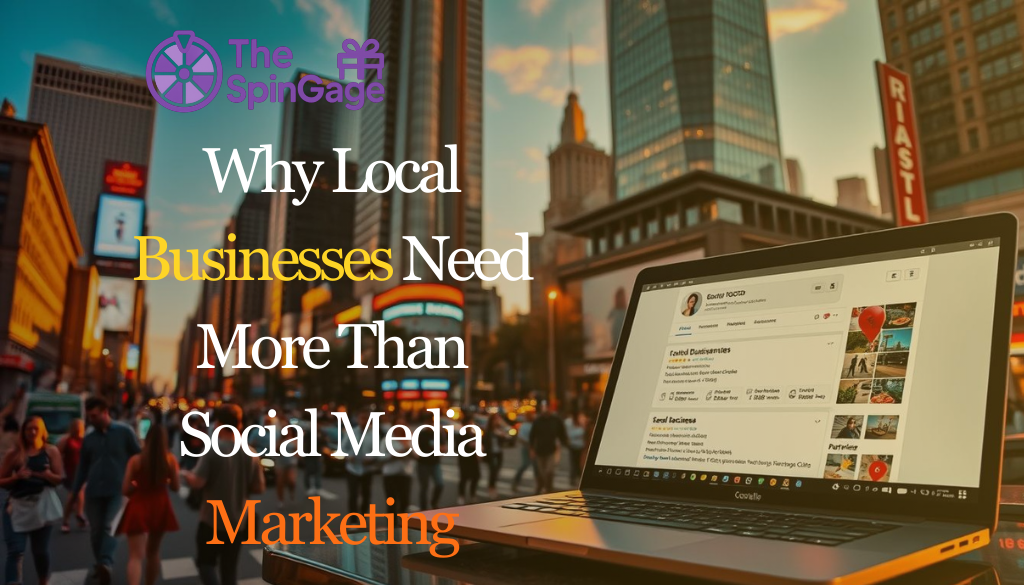


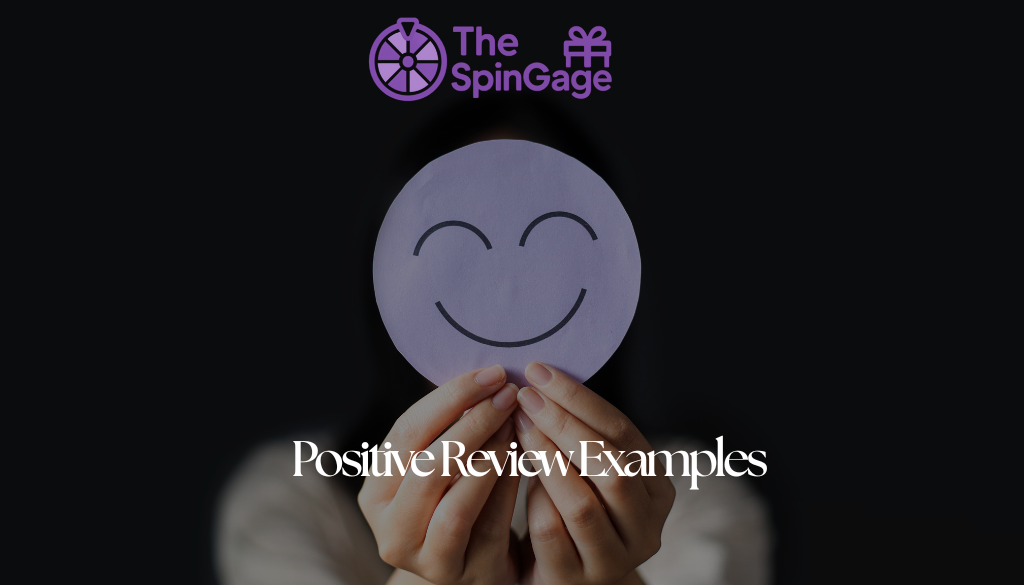
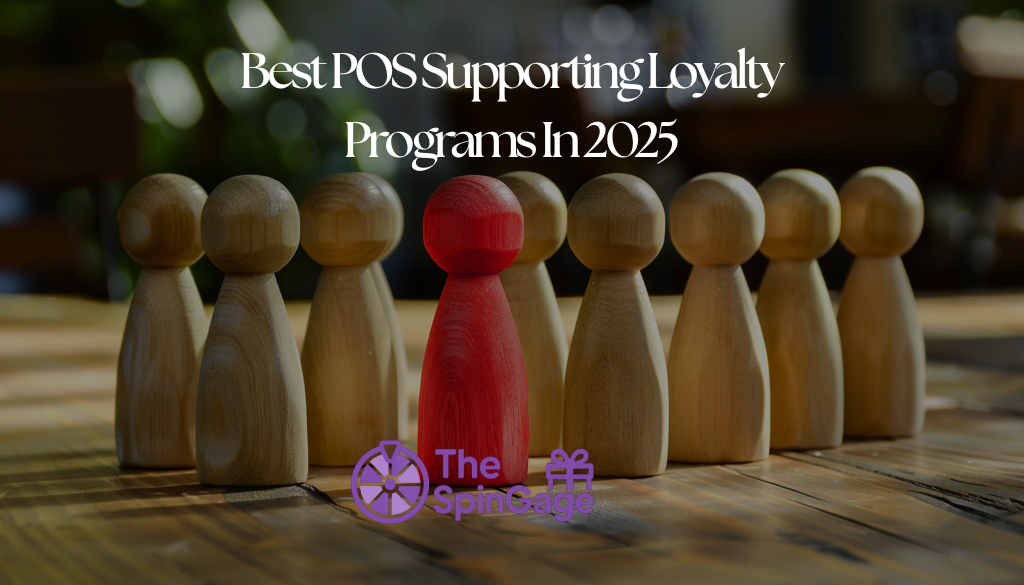
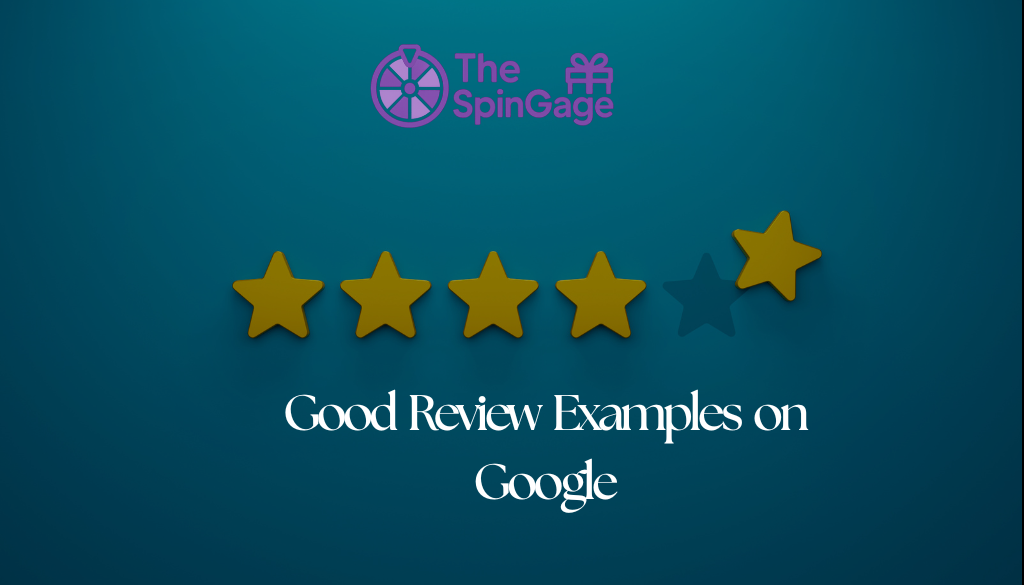



Leave a Reply